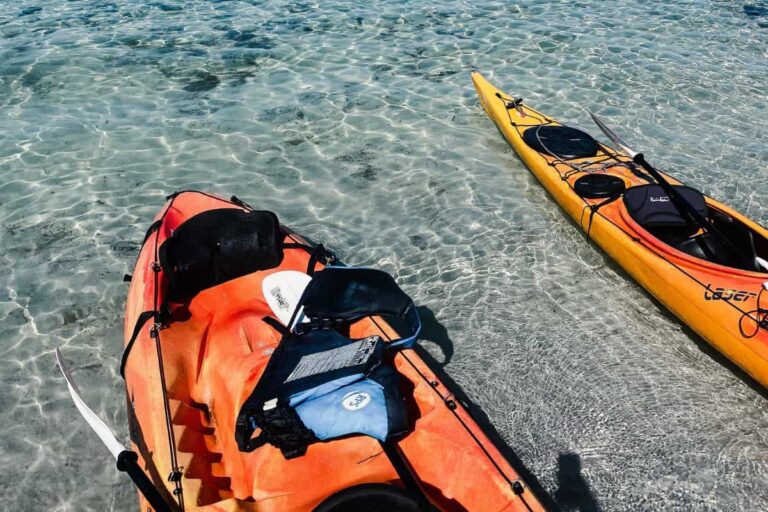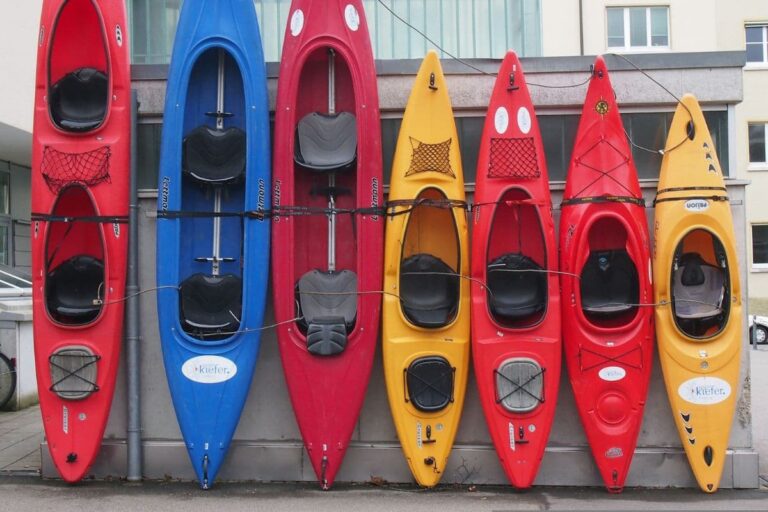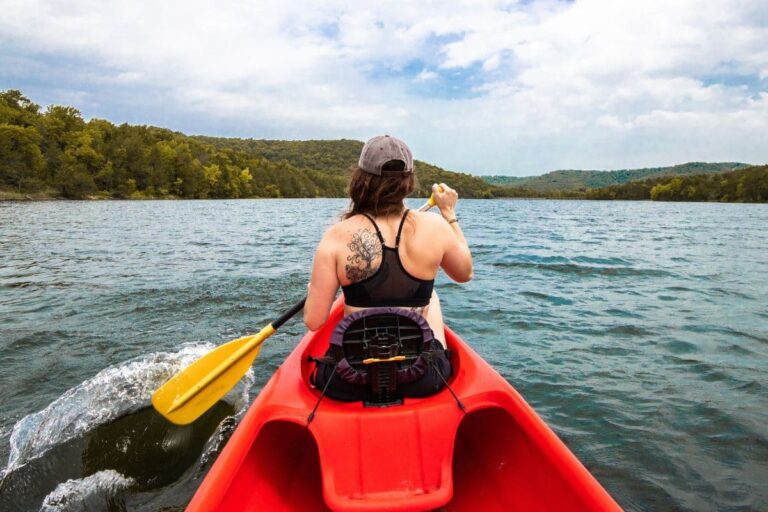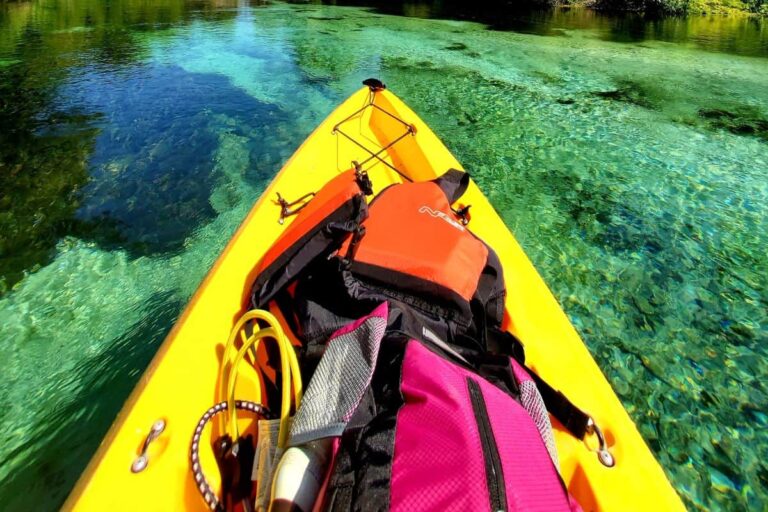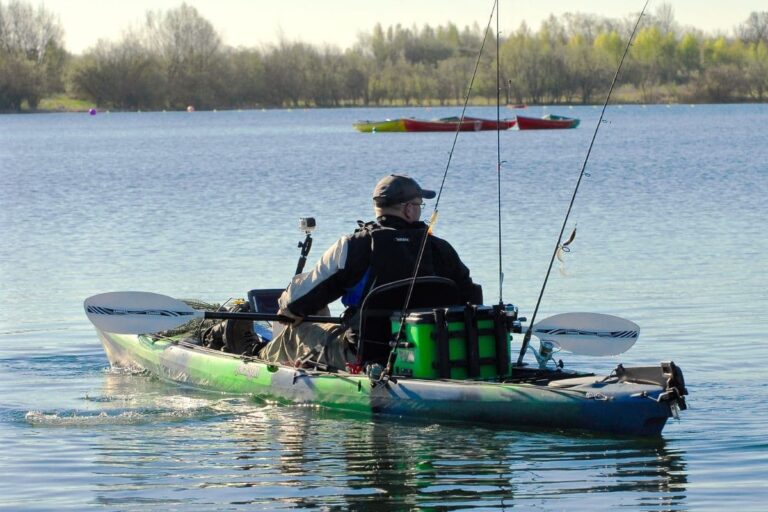Can You Kayak In The Rain? (Safety and Essential Gear)
Even though kayaking in the rain can be fun and exciting, paddlers also must consider the risks involved.
Are you wondering if it’s safe to take a kayaking trip in the rain, or after a rain storm?
There are ways to make kayaking in the rain safe, enjoyable, and exciting. Just be sure to check the weather and water conditions ahead of time, determine how you’ll keep water out of your boat, wear the proper gear, and make a proactive plan to ensure your safety before your trip.
In this article, we’ll discuss the important factors you need to take into account to ensure a safe and fun adventure.
Important Things To Remember When You Kayak In The Rain
Safety
Kayaking during rainy weather requires you to be mindful of certain precautions and safety measures.
Key steps to remember before going out on the water in the rain include:
Check the Weather Conditions
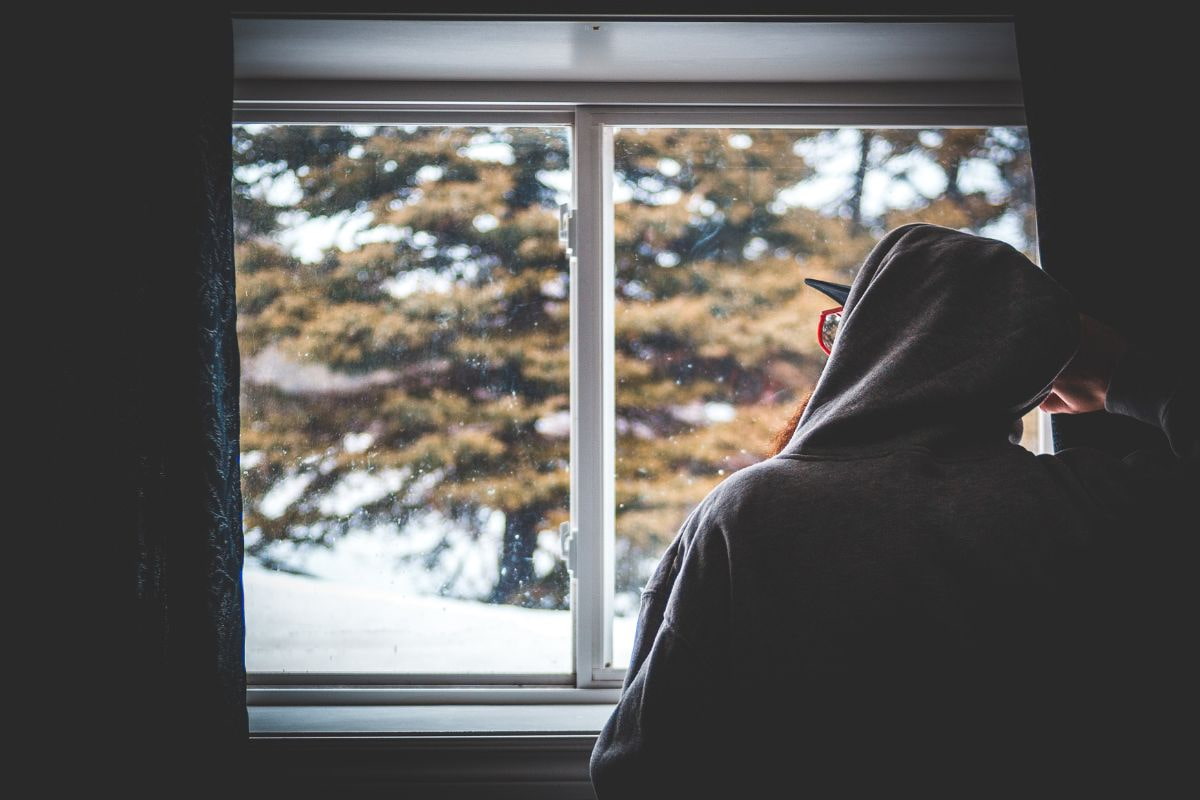
Always take a look at the weather forecast before heading out for a kayaking trip.
If the weather report is clear and there is no chance of rain, you can grab your paddle without a worry.
But if the forecast is predicting inclement weather, it’s important to take appropriate measures and plan accordingly.
It’s also a good idea to check the weather from the previous week as well, to see if there’s been any heavy rain that may have raised the water level.
Oftentimes, a river can develop fast-flowing rapids and dangerous conditions as the water level rises after unexpectedly heavy rains.
Maintain Visibility
Rain decreases and obstructs visibility within a one mile radius.
This lower visibility makes it harder to spot upcoming obstacles, and anything from a rock to a floating log could get in your way.
The harder it pours on a rainy day, the more difficult it is to see.
Equipping your kayak with a white kayak light on will help you see your surroundings, remain visible to other people on the water, and be easier to find in case of an emergency.
While kayaking in lighter rain may be fun, reduced visibility caused by heavy rain is one reason many kayakers choose to stay home.
Use A Spray Skirt To Keep Water Out Of Your Boat
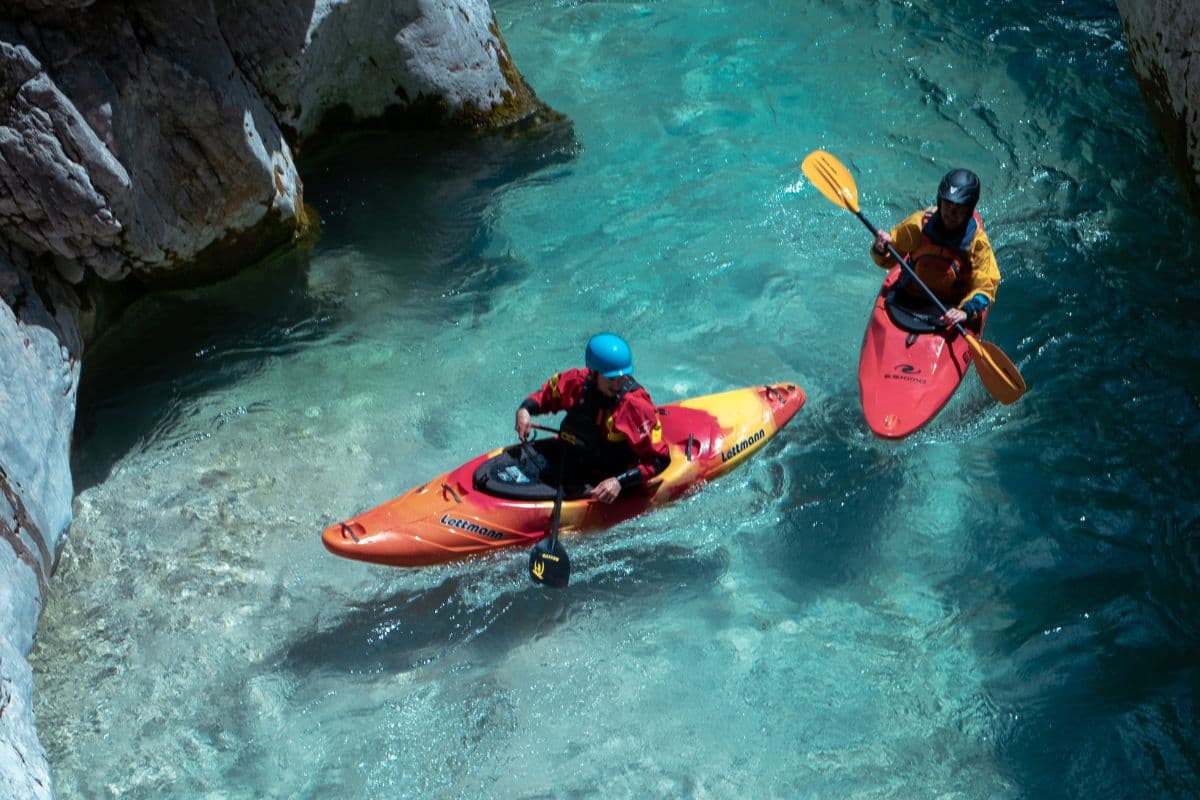
The easiest way to prevent water from getting inside your kayak is to install a spray skirt.
You can get a basic, inexpensive nylon skirt to keep the water out.
A neoprene skirt is another option, but it’s slightly pricier than the nylon skirt – however, it’s also waterproof and incredibly comfortable, which is why this material is generally advised during heavier rainstorms.
You may also go for the GoreTex tunnel skirt, which is the most expensive but also the most effective option.
A waterproof GoreTex tunnel skirt is breathable and will keep you dry for optimal comfort.
How To Drain Water Out Of Your Kayak
If water gets inside your boat, there’s no need to panic – there are ways to remove water quickly.
If you have a sit-in kayak, consider investing in a bilge pump, which makes it easy to remove water that gets inside the boat.
For a sit-on-top kayak, water can be removed through the scupper holes that are built into the kayak.
Plan of Action
Always prepare an emergency backup plan, in case anything unexpected happens on your kayaking trip.
Having a proactive strategy in place will help you stay calm and in control when faced with a distressing situation.
Your plan of action should include the following:
Make sure you share your float plan with a friend or family member, and don’t forget to tell them what time they should expect you to be back.
If you plan to float down a river, you may need someone to pick you up at the end of your trip, since it is not recommended to try paddling upstream on rivers.
If you plan to kayak in the rain, choose an easy location where the water conditions are relatively mellow.
Really, any time you participate in fun outdoor activities for an extended period of time, it’s important to let someone know where you are and when you expect to return.
This way, if you don’t arrive back at a reasonable time, they’ll have an idea of where to look for you.
Before you begin your journey, do a routine maintenance check.
Have a waterproof or water-resistant phone, or GPS, turned on for navigation – this is helpful on a sunny day, but it becomes even more necessary when you go kayaking in the rain.
First Aid

First aid supplies should be the first thing you pack in your dry bag.
In addition to traditional first aid supplies, you must always include your safety gear (such as flotation devices and life vests).
Gear and Equipment
The most crucial element of any trip is the type of gear that you bring.
When kayaking in the rain, your main focus should be keeping the weather conditions in mind and bringing along the right gear.
Since you’ll be constantly exposed to water, the chances of catching a cold or hypothermia are increased.
As a result, the following guide to recommended kayaking rain gear will help you stay safe on your trip:
Which Type Of Fabric Is Suitable For Kayaking In Rain?
Synthetic kayak rain gear is a perfect choice for paddling, especially on rainy days.
This fabric dries quickly, wicks moisture away, and works as a good waterproof layer.
Consider both the temperature of the water and the air to help you determine how many layers you need.
In spring and late autumn, it’s usually necessary to bring multiple layers in order to stay warm.
But during summer, a simple wetsuit is often more than enough to keep you comfortable out on the open water.
You can always bring a lightweight, waterproof layer and extra dry clothes in a dry bag just in case.
Wet Suits Or Dry Suits
Everything comes down to staying dry, regardless of the weather conditions.
If you wear a dry suit for paddling, it will help prevent the rain from coming into contact with your body, ensuring you stay completely dry.
Wetsuits, on the other hand, are made from a rubber material that holds a small percentage of water between your skin and the wetsuit as insulation.
You can purchase either a wetsuit and or dry suit from your local surf shop.
Rain Suit
Rain suits consist of a jacket and pants that are almost completely waterproof and very comfortable, but keep in mind that they offer little to no insulation.
You may want to choose a somewhat loose-fitting rain suit to accommodate any layers of clothing you have on underneath for added warmth.
If you wear a rain suit, we do recommend choosing one with tightly cuffed sleeves to keep the rain out while you paddle.
Rash Guard
A rash guard, also known as a “rashie,” is a fitted swim top.
It will usually be made of either nylon, polyester, or lycra, and can be worn alone or under a wet suit.
This garment adds extra comfort by preventing the wet suit from rubbing against your skin.
Waterproof Jackets
These jackets have three layers.
The outer layer is the face fabric, made of polyester or nylon.
The second layer has a lamination coat of teflon or polyurethane.
Finally, the mesh on the inside holds everything together to offer three-layer protection.
In case of unexpected rainy weather, a waterproof jacket will help you stay dry and warm.
Life Jackets
Many individuals panic when they are unexpectedly thrown into deep waters.
Therefore, a life jacket is necessary for anyone paddling out on the open water, since there is always the possibility of capsizing.
We recommend trying on a variety of life jackets to find one that is comfortable and offers you a free range of movement that keeps you safe without hindering your fun.
Hats and Helmets
There are a variety of hats and helmets you may choose to wear while you kayak.
Broad-brimmed hats are perfect for keeping your head dry while kayaking in the rain.
Helmets can also be useful in rough waters to prevent injury in case if a collision occurs and your head knocks against the paddle or rocks.
Footwear
When it comes to footwear for kayaking in the rain, sandals are the most common choice during warm weather, since they help you stay safe by attaching firmly to your feet.
Sandals also offer flexibility and breathability to keep you comfortable all day long.
Although sandals aren’t typically waterproof, they do dry more quickly than most other types of shoes.
You can also pair them with waterproof socks if you want to stay a bit drier, which repel water that may spray or splash onto your feet.
If there is water in the bottom of your boat near your foot controls, or if your foot gets submerged underwater, it will still become wet.
Boots
Boots that are calf-high and sturdy are ideal, as they can ensure you don’t slip or step on anything sharp.
It’s a good idea to invest in a pair of rubber boots, or use a waterproof sealer on your boots, to help increase the longevity of your shoes and keep your feet as dry as possible.
However, just like with the waterproof socks mentioned above, remember that if your foot is submerged in water, the boots will cease to be waterproof!
Consider leaving spare footwear in your vehicle while you kayak so that you can change into dry, warm socks and shoes before driving home.
Gloves
Gloves that are made from polyester or nylon and coated with waterproofing material are ideal for kayaking in rain.
They will repel the water, keeping your hands warm and dry, and can even aid in preventing blisters.
How dangerous is kayaking in the rain?
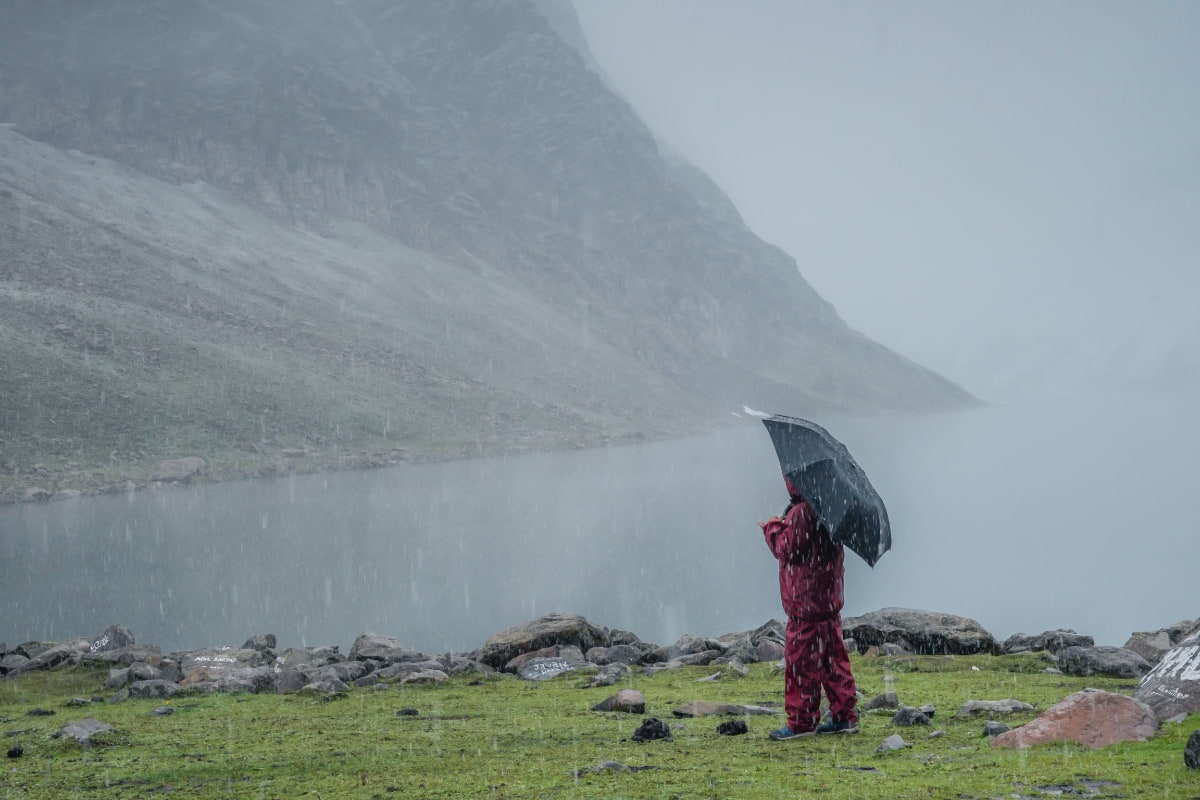
Kayaking in the rain is relatively safe, but there are specific safety rules to keep in mind.
First, be aware of your energy and fitness levels.
If you’re new to kayaking, it’s unlikely that you have the stamina and experience needed to enjoy kayaking in the rain.
Exhaustion can put you at risk of colliding with something in the water, which can cause severe injury, or even result in not having the energy needed to make it back to the shore.
Some paddlers face hypothermia in the rain caused by inadequate clothing after becoming capsized in cold water.
It’s always smart to bring a paddling buddy when you kayak so you can help each other in the event that one of you capsizes.
It’s rare, but there is the chance of getting caught in your kayak during a thunder or lightning storm.
Again, always check the forecast before you go kayaking in the rain to make sure no major storms are expected.
Can you kayak after it rains?
Kayaking after rainfall can be thrilling because the water is calm and fresh, but it can also be unsafe at times.
If possible, download apps that can tell you the predicted water levels.
Additionally, take a look at the current and predicted weather conditions in case strong winds are expected to occur.
Also, be sure to check for wear and damage to your kayak, and learn essential rescue techniques before heading out on the water.
Conclusion
Kayaking in the rain can be an amazing experience.
Just because it’s raining doesn’t mean you have to cancel your adventure!
As long as you can take the necessary precautions and keep yourself guarded against harsh weather conditions, your trip can go smoothly and you’ll stay safe.
Table of Contents

